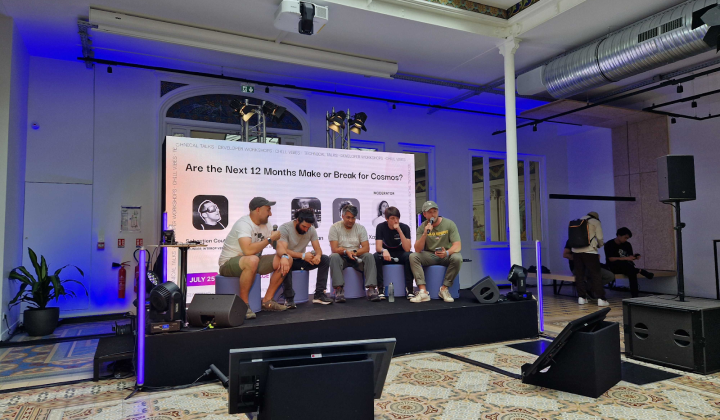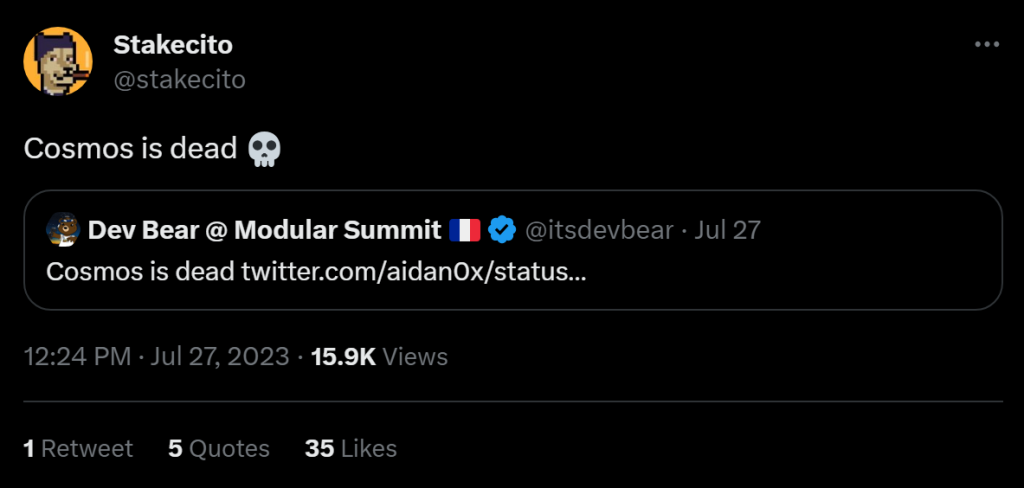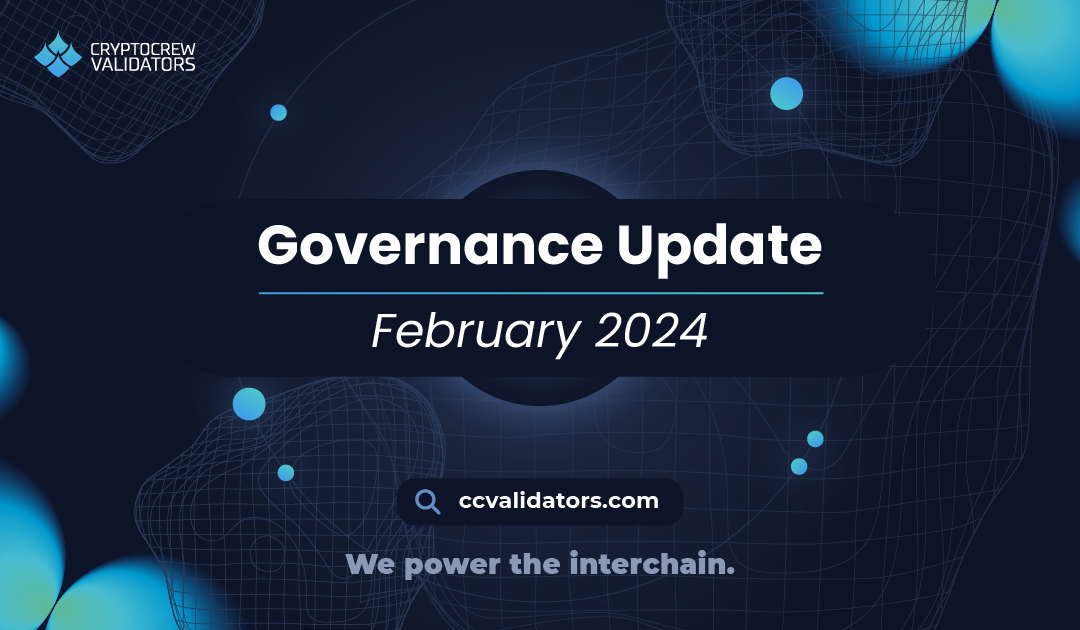
Cosmos is dead 💀 Long live Cosmos
A recap of the recent Cosmos Conferences in Paris 07/23, with some personal flavor added by the author.
Yes, the Interchain is very bottom-up, inclusive, decentralized and diverse. It’s full of innovation, cutting-edge development and drama. However, it also has forgiveness and a true ability of being able to capitalize from feedback and critique. This ability is the vital key to progress as an ecosystem. It makes “the Cosmos” unique in a way that only Bitcoin has ever achieved to be, and Bitcoin has already been declared dead multiple times.
But what is “The Cosmos”?
The Cosmos is a technical vision of how to scale and interconnect blockchains, and also a technological stack. It is an interconnected network of sovereign or subordinate decentralized applications. “The Interchain” complements the term “the Cosmos”, as it paints a more approachable picture of “a Network of Networks”, with every application adding to a shared feature-set.
Why Cosmos, what’s the USP?
During the closing panel at the Nebular Builders Conference in Paris 23/07, Zaki Manian, Ethan Buchman, Spaydh from Neutron and Sebastien Couture of Interop Ventures discussed key-takeaways about the hot topic:
“Are the Next 12 Months Make or Break for Cosmos?”

A tweet by Zaki Manian, that inspired a discourse, that inspired a panel. It also inspired an article of a popular crypto news publisher, that inspired a troll-tweet copy-pasta (that inspired this article’s title). We understand that, if full context gets lost along the way, it can get a little cryptic (pun intended, dear Mr Kessler.)

So if you feel like context got lost for you, here’s some more background info on the whole éclat:
Spoiler alert: Cosmos is far from dead!
Zaki based his original tweet on the fact that the latest 2 big DEX (decentralized exchange) products did not choose the Cosmos SDK software stack to build the technological base of their product, but rather Ethereum L2’s. At the panel at Nebular Conference, Zaki added a very important piece of context: “All the necessary components are in place. We have to demonstrate what you can do on an appchain that you can’t do on an L2 today. It’s a critical moment of execution.”
With dYdX, one of the largest applications on Ethereum is moving to Cosmos. Sovereign appchains offer the best UX. One of the major reasons for dYdX choosing the Cosmos stack over an Ethereum L2 is sovereignty of their application. Having a sovereign validator set enables to slash validators who participate in MEV, increasing capital efficiency and UX.
The “liquidity problem” is about to be solved: The Liquid-Staking-Module (developed by Iqlusion, where Zaki is one of the co-founders) unlocks the ability to “migrate” a traditionally staked delegation to Liquid Staking, without the need to go through the unbonding period. The LSM will be rolled out on Liquid Staking mainnets in the coming months, gradually unlocking big chunks of currently sticky liquidity. In fact, the biggest portion of locked liquidity in the Cosmos is currently locked in traditional staking.
Additionally, as Cosmos’ DeFi infrastructure is thriving, new applications bring in new partners tackling the liquidity problem on other fronts. USDC is about to be deployed on Noble, Kava just minted 90 Mil USDT on their native chain. Wormhole is about to connect to the Cosmos by bringing their cutting-edge bridge tech to a sovereign IBC-connected appchain. This unlocks further liquidity influx from chains like Solana, Aptos, Near, Fantom, Ethereum, various ETH L2’s and many more.
“Ideas like Rollups and Eigenlayer originated in Cosmos” (Zak Manian)
This is essentially true, but the key difference is still sovereignty and alignment. “Cosmos puts values first, that attracts a certain set of applications and people. If we can stick to these values there is a future.” (Ethan Buchman)
Some applications definitely worth a mention that execute on these visions are EVMs as appchain on Cosmos (Evmos, Berachain), Agoric, CosmWasm, Celestia, Dymension. EVM is a prime example: Applications can build on an Ethereum L2, after finding product-market-fit they go appchain to improve UX.
Other prominent examples of perfect execution on the appchain and interoperability vision include Neutron, Stride, and of course Osmosis, whose ability and drive to become the “full feature-stack DEX” of tomorrow is about to materialize (stay tuned for recaps / videos from OsmoCon2023!)
“The competitive landscape is definitely something to pay attention to” (Ethan Buchman). This is the major reason why we always need to keep improving infrastructure, documentation, tooling and developer onboarding mechanisms. The blockchain industry is fast-paced, the modular design of the Cosmos SDK stack is a perfect fit for this environment.
It’s also important to constantly abstract away complexity. During the last year we have seen a shift of focus into this direction within the Cosmos, and an influx of many new teams and projects in this sector like Polymer Labs, Strangelove, Skip and Squid.
“Is IBC the TCP/IP of blockchain interoperability?”
Bo Du (Co-Founder of Polymer Labs): Enshrined Interoperability: Bridges Will Die And What’s Next (live at Nebular Summit 23)
Blockchain bridges today are similar to the many proprietary networking protocols that preceded TCP/IP standardization:
In the times of the “Protocol Wars” during the 70’s and 80’s many protocols were seen as the de-facto industry standards of their time. Prominent examples are IBM SNA, Xerox Network Systems or AppleTalk. Most of these systems became obsolete when TCP/IP gained major adoption as the canonical networking protocol in the mid 80’s.
In the next 10 year period of the blockchain interop wars we are in now, we need to establish IBC as a de-facto industry standard. The open and fault-proof protocol design primes IBC in this position. We already have live IBC connections with Polkadot / Kusama, and teams working on IBC implementations on Ethereum, Avalanche, Polygon and other prominent POS chains.
Bottom Line as a Cosmonaut:
Blockchain infrastructure, in general, needs to keep improving on throughput and UX to become relevant as the preferred layer of data-management for the major part of “real world applications”. We have not seen the “killer blockchain app” yet, and we might not see it for a few years, until the infrastructure isn’t lacking the application’s requirements anymore.
We need to build faster roads, before we can build faster cars.
The Cosmos is primed to become the de-facto standard blockchain infrastructure within the next 10 years. Major adoption is what comes next. Adoption drives user numbers, which drive yield. More applications mean more adoption. We have to view the Interchain in a greater scope, as a whole, with each application adding to the Cosmos feature set.
Most of the “noise” and “drama” is a byproduct of a truly decentralized community of great thinkers. The ability to listen to feedback and critique, in order to capitalize and profit from it over the long term is our true strength. To achieve this it is always important to be humble to each other and to stay aware of the true Cosmos and Interchain values. This is the true reason why all these people get along very fine, when meeting in person at all these conferences. We test in production, we break things to rebuild them in a better way. Sometimes, things need to be declared “dead” to overcome certain periods, to improve, and succeed in the long term.
–
Author: Clemens Scarpatetti, CryptoCrew Validators
In July 2023 the CryptoCrew team attended the OsmoCon, Modular Summit and Nebular Builders Conferences in Paris.























